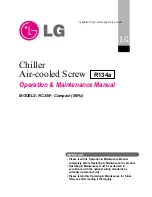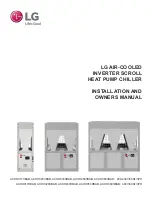
5
Note:
The power supply should never be disconnected, except when
performing maintenance.
Operate (open) the main switch before carrying out any mainte-
nance work on electrical components.
Note:
It is forbidden to work on the electrical components without
using insulating platforms, and in the presence of water or fog
or mist.
Note:
The supply to the external pump assembly mustbe made before
starting the chiller and must be kept on as long as the chiller is
in use. Incorrect operation will cause the unit to lock---out be-
cause of the internal protections (flow switch intervention).
Note:
The compressors are equipped with an electronic protection de-
vice blocking their start if the phase sequence is not correct, or
stopping their operation if a thermal relay intervenes. Thisdevice
is essential for the integrity of the mechanical and electricalcom-
ponents of the compressors. Reset the standard functions by
isolating this device and removing the causes of the lock---out.
Note:
The chillers are equipped with their own microprocessor control
adjustment. The use of the remote ON---OFF input (located in
the electric panel terminal board) as a system temperature con-
trol element is forbidden.
4 --- Start---Up and Operation
4.1 --- Initial check
1) Check all water connections.
2) Open the shut---off valve on the liquid line.
3) Ensure that the intake pressure is higher than 4.0 bar; if this
is not the case, prolong pre---heating of the compressor (if
possible) and check that the refrigerant shut---off valve is
properly sealed, see Fig. 12, Fig. 13, Fig. 14, Fig. 15, Fig. 16
and Fig. 17.
4) Open all isolating valves and/or water ball valves.
5) In case of climates with temperatures below zero degrees C,
make sure the chilled water circuit is filled with the correct
concentration of water/glycol.
6) Bleed all air out of the chilled water circuit.
7) Verify the water flow rate and its direction.
8) Ensure that the thermal load is sufficient for start---up.
Caution:
The ambient air temperature probe must be positioned in the
shade and protected against the weather.
4.2 --- First start---up
(or after a long stop)
Operate as follows:
1)
At least 8 hours before the start---up, power the crank-
case heaters (if any, see point 4) by setting the main iso-
lator switch ON. Make sure the auxiliary circuit has been
powered and check the operation (a fault due to an in-
correct procedure will invalidate the compressor guar-
antee).
2) Open the valves of the refrigeration circuit that had been
closed before the initial check.
3) Check the machinery supplying the thermal load connected
with the unit and start the system pump(s).
4) MAKE SURE THE COMPRESSOR OIL HAS BEEN HEATED
FOR AT LEAST 8 HOURS; start the unit only then. In the
units not equipped with crankcase heaters (Chillers for sum-
mer operation only, without modulating fan speed control),
the start must be carried out in the warm season only (exter-
nal T > 15
û
C), and thus oil pre---heating is not necessary.
5) Make sure the fans rotate in the correct direction (anticlock-
wise): check the electrical connections, if necessary.
6) Make sure the pumps rotate in the correct direction.
7)
During the unit start---up an inlet water temperature
higher than 20
û
C is allowed. Under standard operating
conditions check that the limits indicated in paragraph
2.1 are not exceeded.
8) Check the correct operation of the control and safety de-
vices.
9) Check the outlet temperature of the chilled water (check if
the set---point set on the controller is reached).
10) Check the compressor oil level.
11) With the compressor at full load, check there are no
bubbles visible in the frefrigerant sight glass. If there are any,
charge the unit according to par. 5.
4.3 --- Starting and stopping
ALWAYS ENSURE THAT THE COMPRESSOR OIL HAS BEEN
PREHEATED.
FOR BRIEF STOPPAGES MAINTAIN THE SUPPLY TO THE
CRANKCASE HEATER (IF ANY).
S
Start the unit setting the Microprocessor switch
ON.
S
Stop the unit setting the Microprocessor switch
OFF
.
S
In case of long stops, turn the machine off using the Micro-
processor switch OFF.
In this case the compressor crankcase heaters (if any) re-
main powered.
S
For seasonal shutdown of the unit operate the main switch
located on the main electrical power supply. This will discon-
nect the compressor crankcase heaters.
4.4 --- Chillers serving special plants
The units are capable of cooling a water---glycol mixture to tem-
peratures close to 0
û
C without the need for significant modifica-
tions. In the case of modification, the set values of the safety and
control components must also be changed. This can be carried
out in the factory (at the time of testing) or at the time of installa-
tion, only by qualified and authorised personnel.
4.5 --- Freecooling
The “freecooling” is a system of pre---cooling and/or cooling the
water/glycol mixture using ambient air when the latter isat a tem-
perature below the return mixture temperature. If the outside
temperature is sufficiently low to dissipate the entire heat load,
the refrigeration compressors automatically switch off, and the
mixture’s temperature is controlled by the fan speed adjust-
ment.
If the mixture temperature is too high for freecooling, the com-
pressors will operate as long as necessary to ensure the correct
water/glycol mixture temperature.
4.6 --- Microprocessor control
Consult the ”Microface and Hiromatic” Service Manual.
5 --- Refrigerant and Oil Charge
All work on pipes or components of the refrigerating circuit un-
der pressure must be exclusively carried out by qualified staff,
competent in such works.
5.1 --- Refrigerant charge
WHILST REPAIRING THE REFRIGERATING CIRCUIT RE-
COVER ALL THE REFRIGERANT IN A CONTAINER: DO NOT
ALLOW IT TO ESCAPE. NEVER USE THE COMPRESSOR
FOR THE SYSTEM VACUUM (THIS INVALIDATES THE
WARRANTY).
S
The unit is delivered charged according to the Tab. 2.
Warning for the refrigerant charge:
S
Ensure there are no refrigerant leaks.
S
Check the refrigerant type in the refrigeration circuit: a unit
originally charged by the manufacturer with R407C cannot
be charged with R22 and vice versa; possibly apply to the
Technical Support Department.









































